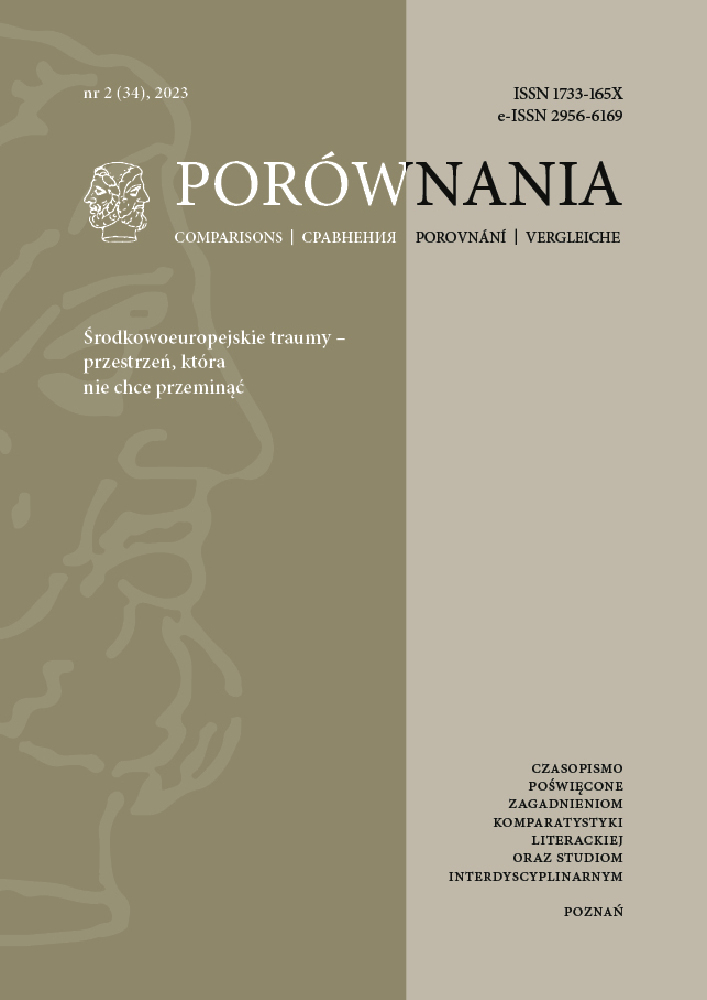Abstract
After their electoral victory in 2015, the Law and Justice party started a counter-revolution in historical policy, intended to undermine critical historiography on the Holocaust. As a result, “dead rescuers,” Poles who lost their lives saving Jews during the Second World War, are commemorated by a host of institutions: a government-sponsored research institute, museums, and the Catholic Church. This commemoration borrows its aesthetics from earlier practices established in Holocaust memory: post-traumatic architecture, lists of victims, and micro-history to boost national pride and defend the good name of Poland abroad. Memory actors receive financial support from the government, becoming a mouthpiece for its reclaiming of the past for ethnonationalist ends.
Literaturhinweise
Cole, Tim, and Alberto Giordano. “Geographies of Holocaust Rescue: Spatial Patterns and Social Geographies of Jewish Rescue in Budapest, 1944.” Journal of Historical Geography 71 (2021): 63–72. DOI: https://doi.org/10.1016/j.jhg.2020.12.002
Engelking, Barbara, Jan Grabowski, eds. Dalej jest noc: losy Żydów w wybranych powiatach okupowanej Polski. Vol. 1 & 2. Warszawa: Stowarzyszenie Centrum Badań nad Zagładą Żydów, 2018.
Florczak, Mateusz. “Niewinność przemocą pisana”. Teksty Drugie 4 (2021): 160–168. DOI: https://doi.org/10.18318/td.2021.4.10
Forecki, Piotr. “Muzeum zgody w Markowej.” Zagłada Żydów. Studia i Materiały 12 (2016): 643–652. DOI: https://doi.org/10.32927/ZZSiM.450
Forecki, Piotr. Po Jedwabnem. Analiza pamięci funkcjonalnej. Warszawa: IBL PAN, 2018. DOI: https://doi.org/10.4000/books.iblpan.14353
Gołębiewski, Arkadiusz, Maciej Pawlicki, dir. Historia Kowalskich. TVP, 2009.
Grabowski, Jan, Shira Klein. “Wikipedia’s Intentional Distortion of the History of the Holocaust.” The Journal of Holocaust Research 2 (2023): 1–58. DOI: https://doi.org/10.1080/25785648.2023.2168939
Hackmann, Jörg. “Defending the ‘Good Name’ of the Polish Nation: Politics of History as a Battlefield in Poland, 2015–18.” Journal Of Genocide Research 20.4 (2018): 587–606. DOI: https://doi.org/10.1080/14623528.2018.1528742
Hartman, Jan. Poniżanie przez prawdę. Antysemicki skandal w Treblince. Polityka.com, 6 December 2021. https://tinyurl.com/mr3af8r3. Accessed 15 Apr. 2022.
Janion, Maria. Do Europy – tak, ale razem z naszymi umarłymi. Warszawa: Sic!, 2000.
Kobielska, Maria. “Polska pamięć autoafirmacyjna.” Teksty Drugie 6 (2016): 358–374. DOI: https://doi.org/10.18318/td.2016.6.21
Kotwas, Marta, Jan Kubik. “Symbolic Thickening of Public Culture and the Rise of Right-Wing Populism in Poland.” East European Politics and Societies and Cultures 33.2 (2019): 435–471. DOI: https://doi.org/10.1177/0888325419826691
Kowalska-Leder, Justyna. “Wszechobecność Sprawiedliwych.” Zagłada Żydów. Studia i Materiały 10 (2014): 1073–1082. DOI: https://doi.org/10.32927/ZZSiM.578
Lanzmann, Claude, dir. Shoah. The Criterion Collection, 2013 [1985].
Leszczyński, Adam. Duda zmyślił sprawę 8 szarytek spalonych za ukrywanie Żydów? Apelował o „prawdę”, więc sprawdziliśmy. Okopress, 24 September 2021. https://tinyurl.com/2p8sn9j6. Accessed 15 April 2022.
Łysak, Tomasz. “Kultura popularna.” Reprezentacje Zagłady w kulturze polskiej. Problematyka Zagłady w sztukach wizualnych i popkulturze, vol. 2. Eds. Sławomir Buryła, Dorota Krawczyńska, and Jacek Leociak. Warszawa: IBL PAN, 2021. 463–617.
Maszkowski, Rafał. “Inny świat: obraz Żydów w Radio Maryja.” Kwartalnik Historii Żydów 4 (2006): 669–687.
Michlic, Joanna Beata. “Daily Life of Polish Women, Dedicated Rescuers of Jews during and after the Second World War.” Women and the Holocaust: New Perspectives and Challenges. Eds. Andrea Pető, Louise Hecht, and Karolina Krasuska. Warszawa: IBL PAN, 2015. 215–234.
Michlic, Joanna Beata. “We Are the Creators of Our History. Poland is Ours.” The Many Faces of the Far Right in the Post-Communist Space: A Comparative Study of Far-Right Movements and Identity in the Region. Ed. Ninna Mörner. Huddinge: Södertörn University, 2022. 115–127.
Molisak, Alina. “Sprawiedliwi w kaplicy.” Pomniki pamięci – miejsca niepamięci.Eds. Katarzyna Chmielewska and Alina Molisak. Warszawa: IBL PAN, 2017. 35–54. DOI: https://doi.org/10.4000/books.iblpan.10127
Olick, Jeffrey. The Politics of Regret: On Collective Memory and Historical Responsibility. Routledge: New York, 2007.
Podbielska, Alicja. “Święta rodzina z Markowej : kult Ulmów i polityka historyczna.” Zagłada Żydów. Studia i Materiały 15 (2019): 575–606. DOI: https://doi.org/10.32927/ZZSiM.2020.15.24
Van Alphen, Ernst. “List Mania in Holocaust Commemoration.” Revisiting Holocaust Representation in the Post-Witness Era. Eds. Diana I. Popescu and Tanja Schult. London: Palgrave Macmillan, 2015. 11–27. DOI: https://doi.org/10.1057/9781137530424_2
Wassermann, Elisabeth. “The Europeanization of Holocaust and World War II Memory in Poland – General Remarks.” Studia Europejskie – Studies in European Affairs 2 (2019): 8–25. DOI: https://doi.org/10.33067/SE.2.2019.1
Wóycicka, Zofia. “Global Patterns, Local Interpretations: New Polish Museums Dedicated to the Rescue of Jews during the Holocaust.” Holocaust Studies: A Journal of Culture and History 25.3 (2019): 248–272. DOI: https://doi.org/10.1080/17504902.2019.1567660
Young, Liam Cole. List Cultures: Knowledge and Poetics from Mesopotamia to BuzzFeed. Amsterdam: Amsterdam University Press, 2017. DOI: https://doi.org/10.1017/9789048530670
Zarzycki, Jerzy, dir. Biały niedźwiedź. Zespół Filmowy Syrena, 1959.
Zynek-Mahometa, Justyna. “‘Droga do wolności’ czy ‘teatr hipokryzji’? O ‘różańcu do granic’ w dyskursie internetowym portalu społecznościowego Facebook.” Lud 102 (2018): 383–407. DOI: https://doi.org/10.12775/lud102.2018.14
Żarnecka, Paulina. “Biomitografia zakwestionowana. Sendlerowa. W ukryciu Anny Bikont jako performans tekstualny.” Przestrzenie Teorii 34 (2020): 147–164. DOI: https://doi.org/10.14746/pt.2020.34.6
Żukowski, Tomasz. Wielki retusz: jak zapomnieliśmy, że Polacy zabijali Żydów. Warszawa: Wielka Litera, 2018.
Lizenz
Copyright (c) 2023 Tomasz Łysak

Dieses Werk steht unter der Lizenz Creative Commons Namensnennung - Keine Bearbeitungen 4.0 International.
Utwory opublikowane w czasopiśmie „Porównania”, na platformie Pressto należącej do Uniwersytetu im. Adama Mickiewicza w Poznaniu są udostępniane na licencji Creative Commons Uznanie autorstwa - Bez utworów zależnych 4.0 Międzynarodowe (CC BY-ND 4.0)
Tym samym wszyscy zainteresowani są uprawnieni do korzystania z utworów opublikowanych pod następującymi warunkami:
-
uznania autorstwa — czyli obowiązek podania wraz z rozpowszechnianym utworem informacji o autorstwie, tytule, źródle (odnośniki do oryginalnego utworu, doi) oraz samej licencji
-
bez utworów zależnych — remiksując, przetwarzając lub tworząc na podstawie utworu, nie wolno rozpowszechniać zmodyfikowanych treści.
-
brak dodatkowych ograniczeń — nie można korzystać ze środków prawnych lub technologicznych, które ograniczają innych w korzystaniu z utworu na warunkach określonych w licencji.
Uniwersytet im. Adama Mickiewicza w Poznaniu zachowuje prawo do czasopisma jako całości (układ, forma graficzna, tytuł, projekt okładki, logo itp.).
Autor zachowuje prawa majątkowe, ale udziela zgody Uniwersytetowi im. Adama Mickiewicza w Poznaniu na wykorzystanie dzieła. Autorzy tekstów zakwalifikowanych do publikacji proszeni są o wypełnienie podpisanie i przesłanie umowa (PL) agreement (EN)
Agreement for granting a royalty-free license to works with a commitment to grant a CC sub-license





